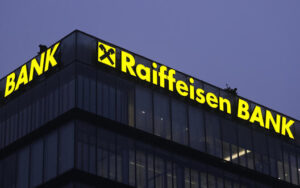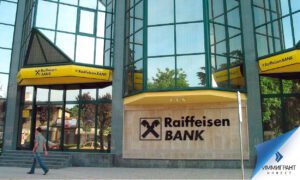
The Supervisory Board of Raiffeisen Bank appointed Sebastian Rubaj for the position of the Deputy Chairman of the Management Board of the Bank. He will assume his duties on this position starting from September 4, 2023.
Sebastian Rubaj will be the Chief Retail Officer.
Before the appointment for this position Sebastian Rubaj (46 years old, from Poland) was a Deputy Chairman of the Management Board in FUIB from September 2014 to April 2023.
Starting from 2007, he held the position of the vice-president, and starting from 2009 – the position of the Chairman of the Management Board of Renaissance Credit Bank. He was also the Board Member of Sygma Bank (Poland) and has experience of working in the Polish branch of PricewaterhouseCoopers.
He got the education in the area of finances and banking in Cracow University of Economics and Hogeschool Brabant Breda.
***
Raiffeisen Bank JSC was registered on March 27, 1992, from October 2005 it became a part of the Austrian Banking Group Raiffeisen Bank International AG. As of June 30, 2023, Raiffeisen Group owned 68.21% of the bank’s shares, and the European Bank for Reconstruction and Development owned 30%.
A wide range of banking services is provided to 2.9 mio customers of Raiffeisen Bank via the network, which includes 300 branches around Ukraine, as well as Raiffeisen Online and Raiffeisen Business Online applications and other remote channels 24/7.

Net unconsolidated profit of Raiffeisen Bank (Kiev) for January-June this year amounted to UAH 3 billion 118.67 million, which is five times higher than in the same period of 2022, according to the unaudited report of the bank on its website.
According to it, in the second quarter of this year, the bank increased the financial result to the second quarter of last year by 39.6% – up to UAH 1 billion 57.54 million.
It is indicated that Raiffeisen Bank’s net interest income for January-June 2023 increased by 53.0% to UAH 7 billion 907.76 million, including in the second quarter – by 43.8% to UAH 3 billion 955.68 million.
As follows from the report, net commission income for the first six months of this year increased by 82.6% to UAH 1 billion 267.64 million, including in the second quarter – twice, to UAH 639.79 million.
At the same time, net profit from foreign currency transactions decreased by 12.8% to UAH 903.49 million in the first half of the year, while the loss from decreased utility increased by 7.9% to UAH 3 billion 127.34 million.
According to the report, in January-June this year, the bank’s assets grew by UAH 5.84 billion, or 3.5% – to UAH 172.10 billion.
Such growth is explained by a significant increase in investments in securities – from UAH 25.41 billion to UAH 34.17 billion, cash and funds with the NBU – from UAH 32.04 billion to UAH 38.15 billion and loans and advances to banks – from UAH 39.08 billion to UAH 42.26 billion.
At the same time, loans and advances to customers decreased from UAH 61.69 billion to UAH 50.25 billion.
Raiffeisen Bank’s customer funds for the first half of 2023 increased from UAH 143.61 billion to UAH 146.50 billion, while the bank’s capital increased from UAH 17.06 billion to UAH 20.17 billion, including retained earnings – from UAH 1.58 billion to UAH 3.14 billion.
In a press release on Tuesday, the bank added that its gross revenues for the first six months of 2023 grew by 48% to UAH 10.4 billion, the amount of taxes paid amounted to UAH 1.1 billion, and its portfolio of government bonds grew by almost UAH 10 billion.
“Raif’s lending dynamics reflect the existing demand for loans and the creditworthiness of customers. Since the beginning of 2023, the bank issued UAH 48.2 billion of new loans, of which UAH 32.6 billion – to industries that are critical for the country (agribusiness, retail, pharmaceuticals, fuel supplies)”, – indicated the financial institution, specifying that UAH 13.5 billion of loans were directed to agrarians.
It is noted that as of June 30, 2023, the bank formed UAH 14.6 billion of reserves, and the share of non-performing loans (NPL) amounted to 16.3% at the end of June.
It is also specified that the funds of corporate customers at the end of June 2023 amounted to 63.1 billion UAH and increased year-on-year by 14 billion UAH, or 29%, while the funds of retail customers increased by 11.2 billion UAH, or 16% – to 81.6 billion UAH.
As of the end of June 2023, the capital adequacy level of Raiffeisen Bank amounted to 25.38% with the minimum value of 10%, and the tier 1 capital adequacy level amounted to 19.03% with the minimum value of 7%.
Raiffeisen Bank JSC was registered in Ukraine in 1992 and is the largest bank with foreign capital in Ukraine, ranking 4th among 65 Ukrainian banks in terms of total assets at the beginning of June. Since October 2005, the bank became part of the Austrian banking group Raiffeisen Bank International AG. As of March 31, 2023, Raiffeisen Group owned 68.21% of the bank’s shares, while the European Bank for Reconstruction and Development owned 30%.

Raiffeisen Bank has allocated UAH 40 million for the project “Zahystok: Bezpechna Osvita” (Bezpechna Osvita) launched by the Kyiv School of Economics (KSE Institute) and the KSE Foundation to provide school shelters for 30,000 school children.
“The full-scale war violates one of the main rights of children – to get an education,” the bank’s press service said in a statement on Thursday.
It is pointed out that the Zahystok project was created by the KSE last September and includes activities ranging from physical sheltering in schools to creating innovative educational programs in the robotics, AI and STEM industries.
According to the KSE website, the project has raised $1.4m against a stated goal of $3m. Farmak, FUMB, Dragon Capital, OKKO and Kyivstar are also among the benefactors.
During the project period more than 8 thousand school and pre-school pupils returned to their desks, while the KSE Charitable Foundation increased its goal from 100 to 300 equipped stores across the country and plans to return another 10 thousand schoolchildren to their schools by September 1 this year.
The basic condition for schools to be allowed to return to offline classes is the availability of a shelter that meets KSE’s requirements. The KSE Foundation installs modern shelters in accordance with all sanitary and safety standards.
It is specified that everyone who cares can join the collection. You can make a contribution in your personal Raiffeisen Online cabinet in the section “Payments/Assistance to Ukrainians” or at the KSE Foundation website.
For their part, each school without a secure vault for students may file an online application to set up a vault on the KSE’s website.
Since the beginning of the war the KSE Foundation has raised $50.4 million for various projects.

Raiffeisen Bank is planning to send its profits for 2022 less dividends in the amount of UAH 1.572 billion to the bank’s reserve fund.
According to a report in the system of the National Securities and Stock Market Commission (NSSMC), the relevant decision will be considered at the remote gathering of the bank’s shareholders on April 28.
It is pointed out that the bank plans to deduct UAH 700 th from the profit for 2022 to pay dividends to the owners of the bank’s preferred shares before sending them to the reserve fund.
According to the National Bank of Ukraine, Raiffeisen Bank on the size of assets as of January 1, 2023, was in 5th place (187.26 billion UAH) among 67 operating Ukrainian banks.

Raiffeisen Bank’s profit for January 2023 was UAH 742 million, up 62% from the same period in 2022 (UAH 457 million), the bank’s press service said Thursday.
According to the report, the bank’s income in January amounted to 1.8 billion UAH, which is 1.6 times more than in January 2022 (1.1 billion UAH).
Including net interest income amounted to 1.4 billion UAH, or 78% of the total income.
It is indicated that the fee and commission income increased by 28% up to UAH 270 billion, indicating the growth of client operations, including remote service channels.
The trade result grew by 30% year-on-year and made up UAH 124 mln.
Besides, in January the bank allocated UAH 380 mln. to provisions for possible credit and operational risks caused by war, that is 4.7 times more than a year before.
The share of NPLs in the loan portfolio of the bank by the end of January was 14.8%, while the loan portfolio decreased slightly to UAH 72 bn.
According to the message, funds of corporate clients in Raiffeisen Bank increased by 6 billion UAH to 61 billion UAH, and funds of individuals – by 1% to 6 billion UAH.
It is noted that half of the 300 operating branches of Raiffeisen Bank are equipped with generators and backup communication channels.

The fall of the Ukrainian economy in 2022 will be about 33% according to the baseline scenario, in which the war will last for another month and a half at the most, Alexander Pecheritsyn, a leading analyst at Raiffeisen Bank (Kyiv), said.
“If the war lasts until the end of the year, then (GDP) could fall as much as 45%,” he said at a zoom conference on Tuesday.
Pecheritsyn specified that this is the bank’s third forecast since the beginning of the war. According to him, the initial decline in the economy was estimated at about 15% based on previous fast-moving conflicts in the world, for example, in Georgia. Then, in March, the bank estimated a decline as low as 24%, taking into account the gross regional product and the map of hostilities. In particular, as part of this analysis, a 34% decrease in this year’s crop is expected.
Serhiy Kolodiy, Chief Manager for Macroeconomic Analysis at Raiffeisen Bank, recalled that in 2014-2015, the fall in GDP was approximately 25% compared with pre-war Ukraine (in official statistics, data are compared only for controlled territories).
Pecheritsyn added that in terms of GDP, the bank estimates a 39% drop in private consumption due to the emigration of 15% of the population, lower incomes and negative consumer expectations.
According to him, domestic investment, which is the most vulnerable component, will fall by half this year under the baseline scenario.
“On the positive side, production relocation programs have little effect, but on the scale of the total output, of course, it is small,” the analyst said.
Speaking about inflation, Pecheritsyn noted that the bank still maintains its forecast for this year at 17% after 10% in the past. He explained that the volume of purchases by the National Bank of military bonds in the amount of UAH 60 billion is still within the limits of controllable, in addition, state control over prices and the freezing of utility tariffs affect.
In general, speaking about the work of analysts during the war, Pecheritsyn said that the bank began issuing weekly military reviews.
“War is a new challenge, we are no strangers to them, since there was a coronavirus two years ago. But the current (challenge) is much more difficult,” he stressed.
Pecheritsyn until February of this year served as chief economist at Credit Agricole Bank (Kyiv).
As reported, according to the World Bank, which before the war expected the Ukrainian economy to grow by 3.2% this year, it will fall by 45.1%. According to his report from early April, in 2023 the Ukrainian economy is expected to recover by only 2.1%, which is also worse than previous expectations of 3.5%.
The National Bank of Ukraine predicts a decline in the country’s GDP this year by at least a third, refusing to make more detailed estimates. The IMF expects a 35% decline.